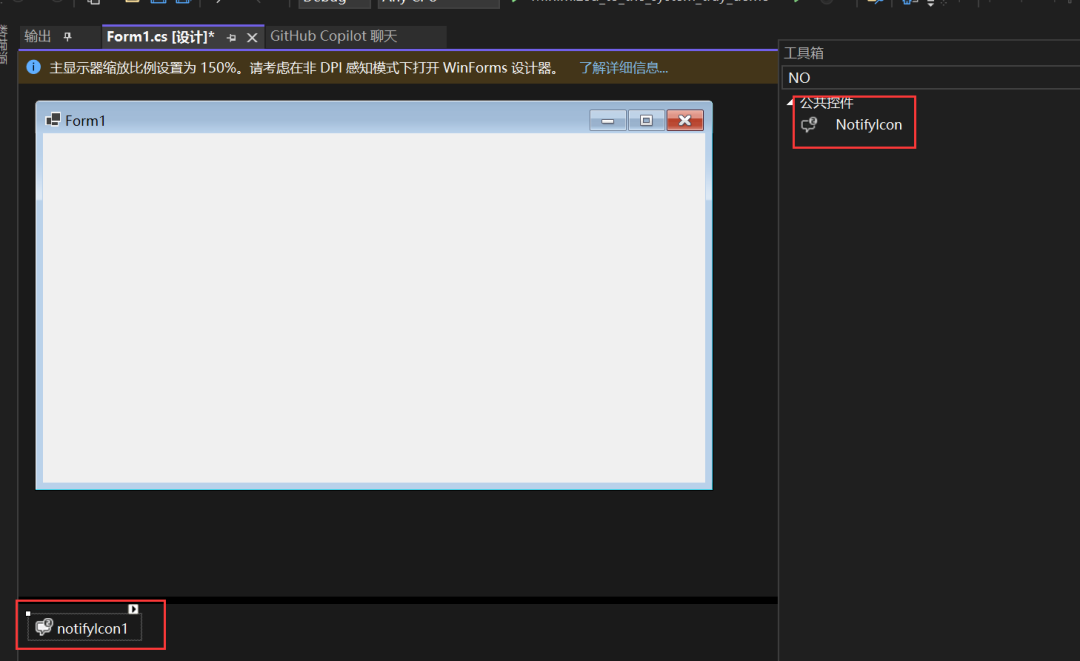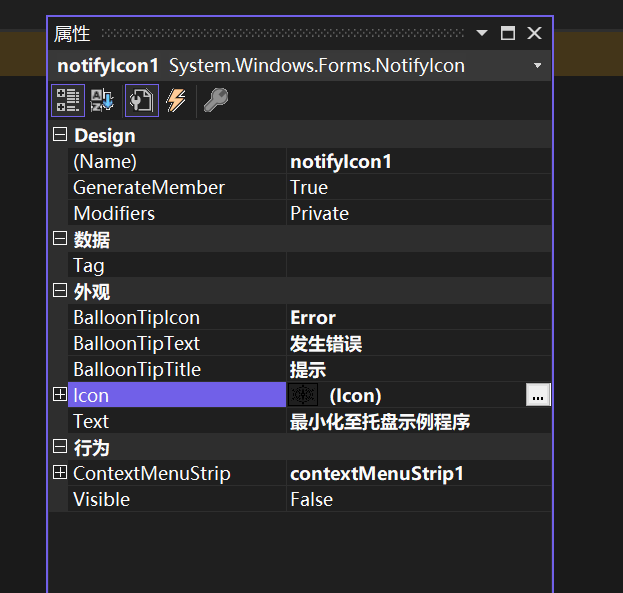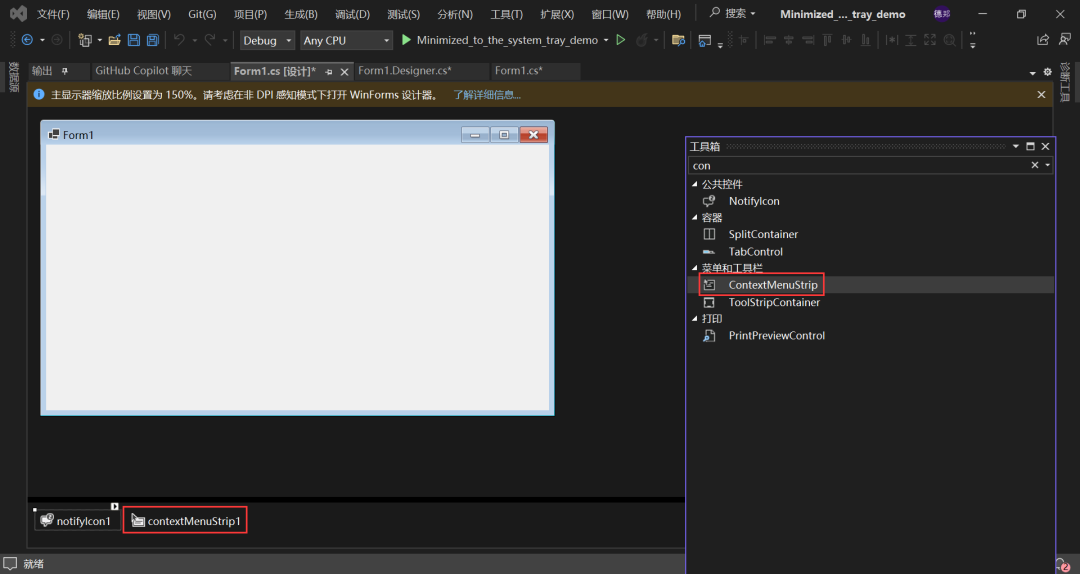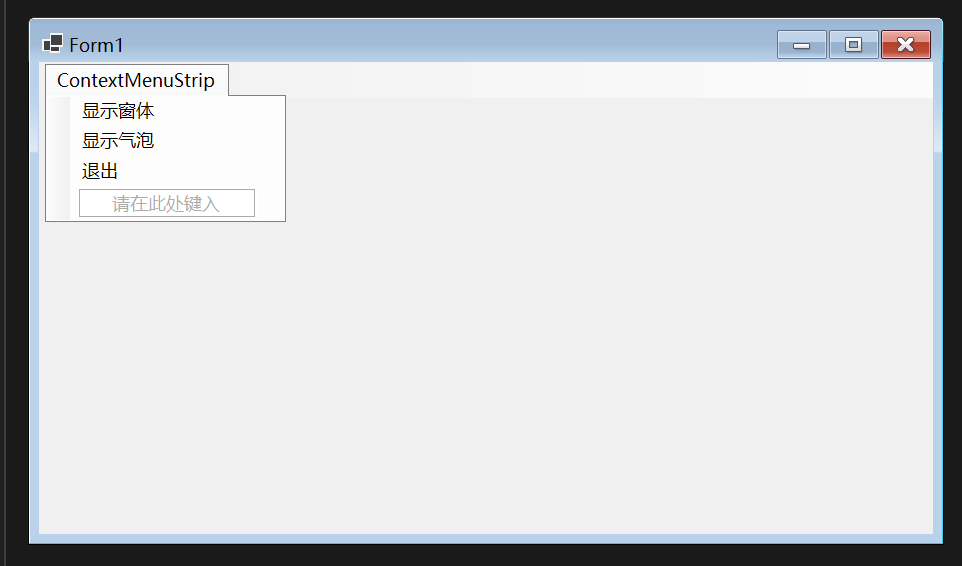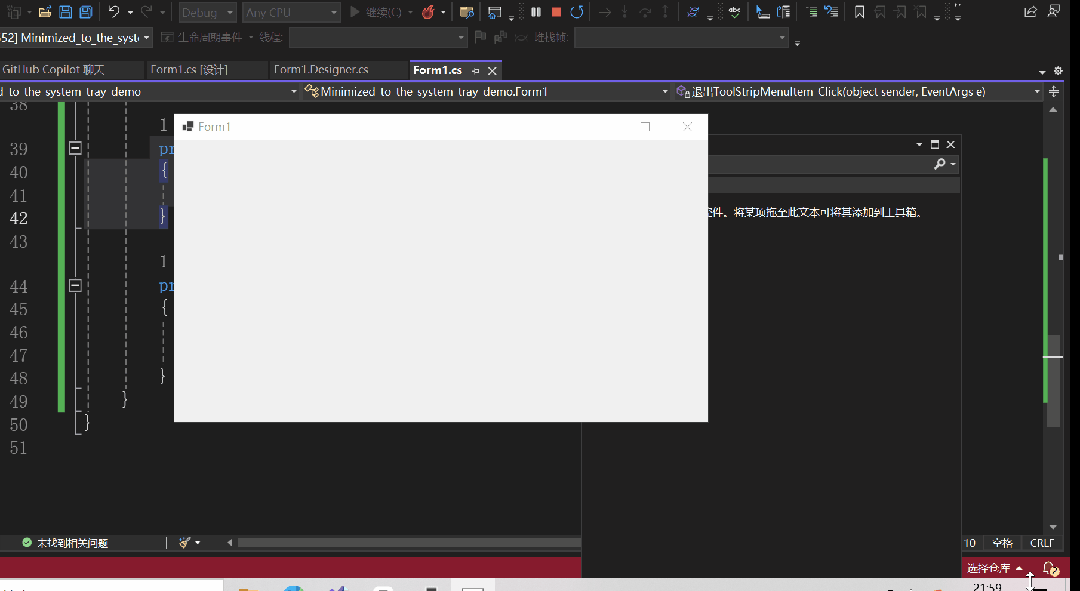NotifyIcon类介绍 NotifyIcon 是 .NET中的一个类,它用于在系统托盘中显示图标。这个类在 System.Windows.Forms 命名空间下。使用 NotifyIcon 类,你可以在系统托盘中创建一个图标,当用户点击或右键点击这个图标时,可以触发一些事件。例如,你可以创建一个上下文菜单(右键菜单),或者当用户双击图标时打开一个窗口。
示例 通过设计页面使用
在设计页面中拖拽添加NotifyIcon:
进行相关设置(在后面通过代码使用时会进行介绍):
这里的contextMenuStrip1也是由自己拖拽来的:
设置contextMenuStrip1:
重写窗体关闭事件处理程序:
protected override void OnFormClosing (FormClosingEventArgs e) if (e.CloseReason == CloseReason.UserClosing) true ; // 取消关闭窗体 this .Hide(); // 隐藏窗体 this .notifyIcon1.Visible = true ; // 显示托盘图标
双击notifyIcon1写鼠标双击事件处理程序:
private void notifyIcon1_MouseDoubleClick ( object sender, MouseEventArgs e) this .Show(); // 显示窗体 this .WindowState = FormWindowState.Normal; // 恢复窗体正常大小 this .notifyIcon1.Visible = false ; // 隐藏托盘图标
双击显示窗体按钮,写点击事件处理程序:
private void 显示 ToolStripMenuItem_Click( object sender, EventArgs e) this .Show(); // 显示窗体 this .WindowState = FormWindowState.Normal; // 恢复窗体正常大小 this .notifyIcon1.Visible = false ; // 隐藏托盘图标
双击显示气泡按钮,写点击事件处理程序:
private void 显示气泡 2 ToolStripMenuItem_Click( object sender, EventArgs e) // 显示气泡提示,参数表示提示显示的时间(单位:毫秒) 3000 );
双击退出按钮,写点击事件处理程序:
private void 退出 ToolStripMenuItem_Click( object sender, EventArgs e) // 退出应用程序
查看实现效果:
winform实现最小至系统托盘效果 全部代码:
namespace Minimized_to_the_system_tray_demo { public partial class Form1 : Form { public Form1 () { InitializeComponent(); } private void Form1_Load (object sender, EventArgs e ) { } protected override void OnFormClosing (FormClosingEventArgs e ) { if (e.CloseReason == CloseReason.UserClosing) { e.Cancel = true ; // 取消关闭窗体 this .Hide(); // 隐藏窗体 this .notifyIcon1.Visible = true ; // 显示托盘图标 } } private void notifyIcon1_MouseDoubleClick (object sender, MouseEventArgs e ) { this .Show(); // 显示窗体 this .WindowState = FormWindowState.Normal; // 恢复窗体正常大小 this .notifyIcon1.Visible = false ; // 隐藏托盘图标 } private void 显示 ToolStripMenuItem_Click( object sender, EventArgs e) { this .Show(); // 显示窗体 this .WindowState = FormWindowState.Normal; // 恢复窗体正常大小 this .notifyIcon1.Visible = false ; // 隐藏托盘图标 } private void 退出 ToolStripMenuItem_Click( object sender, EventArgs e) { Application.Exit(); // 退出应用程序 } private void 显示气泡 2 ToolStripMenuItem_Click( object sender, EventArgs e) { // 显示气泡提示,参数表示提示显示的时间(单位:毫秒) notifyIcon1.ShowBalloonTip( 3000 ); } } }
通过代码实现
首先全局声明一个NotifyIcon对象与一个ContextMenuStrip对象:
private NotifyIcon notifyIcon1; private ContextMenuStrip menuStrip;
menuStrip的相关设置:
// 创建 ContextMenuStrip 。 this .menuStrip = new ContextMenuStrip(); // 创建并初始化 ToolStripMenuItem 对象。 ToolStripMenuItem item1 = new ToolStripMenuItem( " 显示窗体 " ); item1.Click += ( object ? sender, EventArgs e) => { this .Show(); // 显示窗体 this .WindowState = FormWindowState.Normal; // 恢复窗体正常大小 this .notifyIcon1.Visible = false ; // 隐藏托盘图标 }; ToolStripMenuItem item2 = new ToolStripMenuItem( " 显示气泡 " ); item2.Click += ( object ? sender, EventArgs e) => { // 显示气泡提示,参数表示提示显示的时间(单位:毫秒) notifyIcon1.ShowBalloonTip( 3000 ); }; ToolStripMenuItem item3 = new ToolStripMenuItem( " 退出 " ); item3.Click += ( object ? sender, EventArgs e) => { Application.Exit(); // 退出应用程序 }; // 将 ToolStripMenuItem 对象添加到 ContextMenuStrip 的 Items 集合中。 this .menuStrip.Items.Add(item1); this .menuStrip.Items.Add(item2); this .menuStrip.Items.Add(item3);
notifyIcon1的相关设置:
// 创建 NotifyIcon 。 this .notifyIcon1 = new NotifyIcon(); // Icon 属性设置将在系统托盘中显示的图标。 notifyIcon1.Icon = new Icon( " 你的 ico 图标路径 " "); 属性设置当右键点击系统托盘图标时显示的菜单。 属性设置当鼠标悬停在系统托盘图标上时显示的提示文本。 最小化至系统托盘示例程序 "; 气泡提示相关设置 提示 "; 您有一条新消息 "; 注册鼠标双击事件
notifyIcon1鼠标双击事件处理程序:
private void NotifyIcon1_MouseDoubleClick (object ? sender, MouseEventArgs e ) { this .Show(); // 显示窗体 this .WindowState = FormWindowState.Normal; // 恢复窗体正常大小 this .notifyIcon1.Visible = false ; // 隐藏托盘图标 }
重写窗体关闭事件处理程序:
protected override void OnFormClosing (FormClosingEventArgs e ) { if (e.CloseReason == CloseReason.UserClosing) { e.Cancel = true ; // 取消关闭窗体 this .Hide(); // 隐藏窗体 this .notifyIcon1.Visible = true ; // 显示托盘图标 } }
实现效果与上述相同。
全部代码:
using System; using System.Collections.Generic; using System.ComponentModel; using System.Data; using System.Drawing; using System.Linq; using System.Text; using System.Threading.Tasks; using System.Windows.Forms; namespace Minimized_to_the_system_tray_demo { public partial class Form2 : Form { private NotifyIcon notifyIcon1; private ContextMenuStrip menuStrip; public Form2 () { InitializeComponent(); // 创建 NotifyIcon 。 this .notifyIcon1 = new NotifyIcon(); // 创建 ContextMenuStrip 。 this .menuStrip = new ContextMenuStrip(); // 创建并初始化 ToolStripMenuItem 对象。 ToolStripMenuItem item1 = new ToolStripMenuItem( " 显示窗体 " ); item1.Click += ( object ? sender, EventArgs e) => { this .Show(); // 显示窗体 this .WindowState = FormWindowState.Normal; // 恢复窗体正常大小 this .notifyIcon1.Visible = false ; // 隐藏托盘图标 }; ToolStripMenuItem item2 = new ToolStripMenuItem( " 显示气泡 " ); item2.Click += ( object ? sender, EventArgs e) => { // 显示气泡提示,参数表示提示显示的时间(单位:毫秒) notifyIcon1.ShowBalloonTip( 3000 ); }; ToolStripMenuItem item3 = new ToolStripMenuItem( " 退出 " ); item3.Click += ( object ? sender, EventArgs e) => { Application.Exit(); // 退出应用程序 }; // 将 ToolStripMenuItem 对象添加到 ContextMenuStrip 的 Items 集合中。 this .menuStrip.Items.Add(item1); this .menuStrip.Items.Add(item2); this .menuStrip.Items.Add(item3); // Icon 属性设置将在系统托盘中显示的图标。 notifyIcon1.Icon = new Icon( " 你的 ico 图标路径 " ); // ContextMenu 属性设置当右键点击系统托盘图标时显示的菜单。 notifyIcon1.ContextMenuStrip = this .menuStrip; // Text 属性设置当鼠标悬停在系统托盘图标上时显示的提示文本。 notifyIcon1.Text = " 最小化至系统托盘示例程序 " ; notifyIcon1.Visible = true ; notifyIcon1.BalloonTipIcon = ToolTipIcon.Info; notifyIcon1.BalloonTipTitle = " 提示 " ; notifyIcon1.BalloonTipText = " 您有一条新消息 " ; notifyIcon1.MouseDoubleClick += NotifyIcon1_MouseDoubleClick; } private void NotifyIcon1_MouseDoubleClick (object ? sender, MouseEventArgs e ) { this .Show(); // 显示窗体 this .WindowState = FormWindowState.Normal; // 恢复窗体正常大小 this .notifyIcon1.Visible = false ; // 隐藏托盘图标 } private void Form2_Load (object sender, EventArgs e ) { } protected override void OnFormClosing (FormClosingEventArgs e ) { if (e.CloseReason == CloseReason.UserClosing) { e.Cancel = true ; // 取消关闭窗体 this .Hide(); // 隐藏窗体 this .notifyIcon1.Visible = true ; // 显示托盘图标 } } } }
